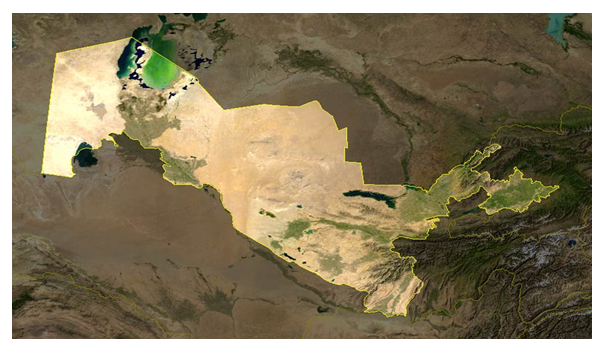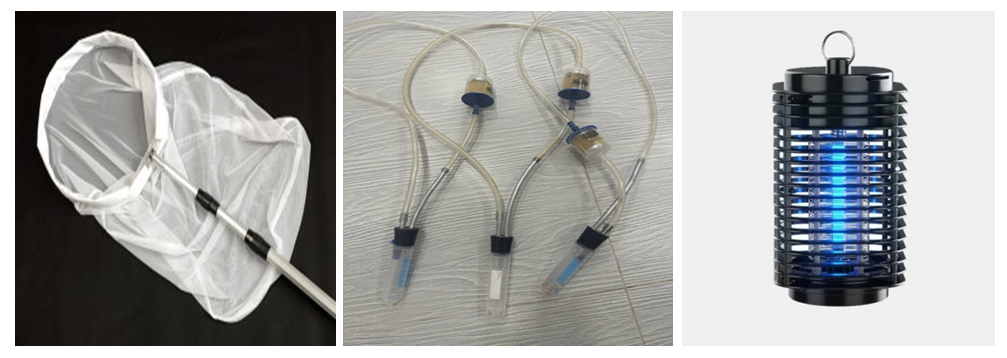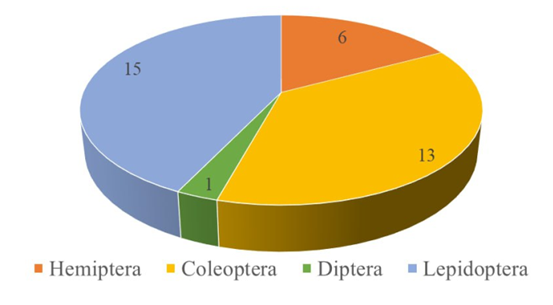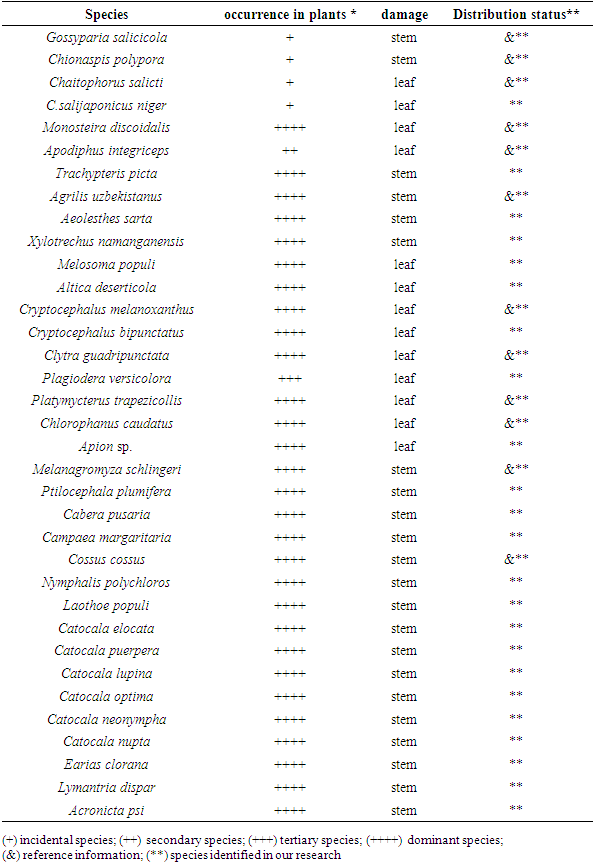-
Paper Information
- Previous Paper
- Paper Submission
-
Journal Information
- About This Journal
- Editorial Board
- Current Issue
- Archive
- Author Guidelines
- Contact Us
International Journal of Genetic Engineering
p-ISSN: 2167-7239 e-ISSN: 2167-7220
2025; 13(1): 12-17
doi:10.5923/j.ijge.20251301.03
Received: Dec. 26, 2024; Accepted: Jan. 22, 2025; Published: Jan. 27, 2025

Species Composition of Salix Pests in the South Aral Sea Forest Ecosystem (Uzbekistan)
Zakhira Bekbergenova1, Dilmurod Abduraxmanov2, Shirin Atajanova3, Abdulla Iskandarov2, 3, Ikram Abdullaev2, 3
1Karakalpakstan Institute of Agriculture and Agrotechnologies, Abdambetov str, Nukus city, Republic of Karakalpakstan, Uzbekistan
2Khorezm Academy of Mamun, Khiva, Markaz str.1, Uzbekistan
3Urgench State University, Urgench, Khamid Alimjan str.14, Uzbekistan
Copyright © 2025 The Author(s). Published by Scientific & Academic Publishing.
This work is licensed under the Creative Commons Attribution International License (CC BY).
http://creativecommons.org/licenses/by/4.0/

The pest insects of the plant Salix in two neighboring regions of Khorezm and Karakalpakstan within the Aral Sea Basin, are listed and described based on literature data and the author’ unpublished research, with a special emphasis on entomofauna. A checklist of pests insects associated with Salix in south Aral Sea areas is presented, incorporating literature records and the latest taxonomic and nomenclatural updates. This checklist of salix pest insects is the first time for Uzbekistan and represents a total of 35 species, within 28 genus, belonging to 19 families, of the pests, recorded from 1995 to 2024 in Uzbekistan. The species composition includes 6 species of Hemiptera, 13 species of Coleoptera, 1 species of Diptera, and 15 species of Lepidoptera.
Keywords: Salix, Pest insects, Khorezm, Karakalpakstan, Aral Sea Basin, Uzbekistan, Biodiversity, Entomofauna
Cite this paper: Zakhira Bekbergenova, Dilmurod Abduraxmanov, Shirin Atajanova, Abdulla Iskandarov, Ikram Abdullaev, Species Composition of Salix Pests in the South Aral Sea Forest Ecosystem (Uzbekistan), International Journal of Genetic Engineering, Vol. 13 No. 1, 2025, pp. 12-17. doi: 10.5923/j.ijge.20251301.03.
Article Outline
1. Introduction
- Insect pests constitute a significant components of forest ecosystems yet their contributions in global environmental change and forestry dynamics has often been overlooked. Despite the mountainous nature of Central Asia, forests cover a relatively small proportion of each country. The forested areas are predominatly composed of Saxaul (Haloxylon spp.), Ulmus, Salix, Populus and other shrubs, especially within the desert and semi-desert landscapes of the region. Willow is a tree belonging to the genus Salix of the Salicaceae family. Two species of it, Salix songarica and Salix wilhelmsiana, are found in the conditions of the South Aral Sea [12,13].The insects of the two neighboring regions of region Khorezm and republic of Karakalpakstan in the Aral Sea Basin are listed and described based on literature data. These regions consist of irrigated farmland, forest-tugay and deserts of Kyzylkum and Karakum. They exhibit a series of different ecosystem types, and reference is made to the corresponding entomocomplexes [15]. Phytophagous insects or herbivorous, are significant pests in Salix and Ulmus forestry. By feeding on plant sap, they cause direct damage to their host plants, leading to discoloration, deformation of leaves and shoots, or the formation of galls and pseudo galls. Pest adults can be dislodged from branches by beating foliage. In spring, evidence of infestation includes sap flow down the trunk and the presence of moist sawdust pushed out of galleries. Adults are often observed walking on trunks or branches, particularly at night. Additional signs of infestation include wilting suckers and pronounced holes in the young stems caused by adults feeding [2,5,6]. Currently, information on impact of pests and diseases affecting forests in Uzbekistan is incomplete. Among the pest, the order Heteroptera or true bugs are a large group with more than 40,000 species in approximately 50 families distributed across the world [11,26]. In Russia, 760 species in 285 genera, and 35 families, are recorded [25], however, more than 1250 species are distributed in Central Asia [7], and 700 species of true bugs are distributed in Uzbekistan [4]. An annotated list of the registered species of pests insects of Salix of the described region is provided. Furthermore, an updated checklist of pest insects affecting Salix in the South Aral Sea areas is presented based, on literature records with the latest taxonomic and nomenclatural changes.
2. Material and Methods
- Study areaThe Republic of Uzbekistan is located between the Amudarya and Syrdarya Rivers, and its total area is 448,900 km2. The territory of the republic is 1,425 km from east to west and 930 km from north to south [16,20]. The Northeast biogeographic regional part of Uzbekistan is situated between the western part of the Tien Shan Mountains and the Syrdarya River [3,21].Uzbekistan’s geographical position at the crossroads of several Central Asian bio-geographical regions underpins the remarable richness of its flora and fauna. This biodiversity reflects the variety of natural conditions across the country, where vast plains occupied by various desert types, mountain steppes, forests, alpine meadows, tugai thickets, and water bodies form distinctive ecosystems [9,10]. Tugai and floodplain ecosystems persist in limited areas along the Amudarya River. Meanwhile, the degraded low mountains and escarpments of Ustyurt Plateau located amidst the desert provide refuge for many rare species. However, at the same time, they are subject to pressure from animal husbandry as well as from the mining industry (building stone, gypsum raw material, etc.). Forest-tugai ecosystems play a vital role in both the economy and environmental protection efforts [19,24]. A peculiarity of most natural ecosystems is their heightened vulnerability, associated with climate aridity. As a resut, the resistance of the ecosystems to external forces is rather low and any anthropogenic interference acts as an additional factor contributing of the degradation of natural systems. The geographical scope of this checklist covers the South Aral Sea areas (Fig. 1).
 | Figure 1. Biogeographic region South Aral Sea areas in Uzbekistan |
 | Figure 2. Equipment used for collecting insects. Nets, aspirator, light trap |
3. Results
- To date, 35 species and subspecies of Salix plant pests have been identified in the South Aral Sea region, based on data from research scientists and our own research. These included 6 species of Hemiptera, 13 species of Coleoptera, 1 species of Diptera, and 15 species of Lepidoptera.Order: Coleoptera Linnaeus, 1758Family: Apionidae Schönherr, 1823Genus: Apion Herbst, 1797Apion sp.Family Buprestidae Leach, 1815Genus: Agrilus Curtis, 1825Agrilus uzbekistanus Stepanov, 1958Genus: Trachypteris Kirby, 1837Trachypteris picta (Pallas, 1773)Family Cerambycidae Latreille, 1802Genus: Aeolesthes Gahan, 1890Aeolesthes sarta Solsky, 1871.Genus: Xylotrechus Chevrolat, 1860Xylotrechus namanganensis Arkhangel’skii, 1941Family Chrysomelidae Latreille, 1802Genus: Altica Geoffroy, 1762Altica deserticola (Weise, 1889)Genus: Chrysomela Linnaeus, 1758Melosoma populi Linnaeus, 1758Genus: Clytra Laicharting, 1781Clytra guadripunctata (Linnaeus, 1758)Genus: Cryptocephalus Geoffroy, 1762Cryptocephalus melanoxanthus Lopatin, 1952.Cryptocephalus bipunctatus (Linnaeus, 1758)Genus: Plagiodera Chevrolat in Deiean, 1836Plagiodera versicolora Laicharting, 1871Family Curculionidae Latreille, 1802Genus: Chlorophanus Schönherr in Sahlberg, 1823Chlorophanus caudatus Fåhraeus, 1840Genus: Platymycterus Marshall, 1918Platymycterus trapezicollis (Ballion, 1878)Order: Diptera Linnaeus, 1758Family: Agromyzidae Fallen, 1823Genus: Melanogromyza Hendel, 1920Melanagromyza schlingeri Sasakawa, 1992Order: Hemiptera Linnaeus, 1758Family: Aphididae Latreille, 1802Genus: Chaitophorus Koch, 1854Chaitophorus salicti (Schrank, 1801)Chaitophorus salijaponicus niger (Mordvilko, 1929)Family: Diaspididae Maskell, 1878Genus: Chionaspis Signoret, 1869Chionaspis polypora Borchsenius, 1949Family: Eriococcidae Brues 1932Genus: Gossyparia Signoret, 1875Gossyparia salicicola Borchsenius, 1949Family: Pentatomidae Leach, 1815Genus: Apodiphus Spinola, 1837Apodiphus integriceps Horvath, 1888Family: Tingidae Laporte, 1832Genus: Monosteira A. Costa, 1862Monosteira discoidalis (Jakovlev, 1883)Order: Lepidoptera Linnaeus, 1758Family: Cossidae Leach, 1815Genus: Cossus (Fabricius, 1793)Cossus cossus (Linnaeus, 1758)Family: Erebidae Leach, 1815Genus: Catocala (Schrank, 1802)Catocala elocata (Esper, 1787)Catocala lupina (Herrich-Schaffer, 1851)Catocala neonympha (Esper, 1805)Catocala nupta (Linnaeus, 1767)Catocala optima Staudinger, 1888Catocala puerpera (Giorna, 1791)Genus: Lymantria (Hubner, 1819)Lymantria dispar (Linnaeus, 1758)Family: Geometridae Leach, 1815Genus: Cabera (Treitschke, 1825)Cabera pusaria (Linnaeus, 1758)Genus: Campaea (Lamarck, 1816)Campaea margaritaria (Linnaeus, 1761)Family: Noctuidae Latreille, 1809Genus: Acronicta (Ochsenheimer, 1816)Acronicta psi (Linnaeus, 1758)Family: Nolidae Bruand, 1847Genus: Earias (Hubner, 1825Earias clorana (Linnaeus, 1761)Family: Nymphalidae Rafinesque, 1815Genus: Nymphalis (Kluk, 1780)Nymphalis polychloros (Linnaeus, 1758)Family: Psychidae Boisduval, 1828Genus: Ptilocephala Rambur, 1866Ptilocephala plumifera (Ochsenheimer, 1810)Family: Sphingidae Latreille, 1802Genus: Laothoe (Fabricius, 1807)Laothoe populi (Linnaeus, 1758)Total 35 species
4. Discussion
- There are very few studies have been conducted on Salix pests in Uzbekistan. Prior to this study, there was no comprehensive checklist of pests Salix in Uzbekistan before this study. In contrast, there are several checklists for other insect groups in this country particularly in recent years [1,14,15,17]. Due to the unique ecosystem, biodiversity and high level of endemism of vascular plants in South Aral Sea forest ecosystem (Uzbekistan) there is a high probability of finding additional new record species and even new species to science. Despite this, the pests fauna of Uzbekistan has not been well investigated yet, considering the country’s high floral and landscape diversity of this country. About 60% of the pests species spend all or part of their life feeding on trees.According to our research, out of the 35 pest species identified on Salix plants, 22 species (63%) were found to damage the stems, while 13 species (37%) were recorded to damage the leaves. Additionally, when studying the relationship of insects with the plants, they were classified into dominant species, incidental species, secondary species, and tertiary species. Four insect species (Gossyparia salicicola, Chionaspis polypora, Chaitophorus salicti, and Chaitophorus salijaponicus niger) were classified as incidental species. One insect species (Apodiphus integriceps) belonged to the secondary species category, one species (Plagiodera versicolora) to the tertiary species category, while the remaining 29 insect species were identified as dominant species (Table 1).
|
 | Figure 3. The ratio of pest orders of willow (Salix) under the conditions of Karakalpakstan |
ACKNOWLEDGMENTS
- We are grateful to the Committee on Ecology and Environmental Protection of the Karakalpakstan (Republic of Uzbekistan) for its close cooperation. In addition to the deceased professor A.Sh. Khamraev and to the team of Khorezm academy of Mamun, Academy of Sciences of the Republic of Uzbekistan and Karakalpakstan Institute of Agriculture and Agrotechnologies for granting permission to use insects species collections.
CONFLICT OF INTERESTS
- The authors declare that there is no conflict of interest regarding the publication of this paper.
 Abstract
Abstract Reference
Reference Full-Text PDF
Full-Text PDF Full-text HTML
Full-text HTML